The global fleet of Eurofighter Typhoon aircraft have passed the 500,000 flying hours mark.
The Eurofighter Typhoon has rapidly accumulated hours across the fleet, particularly in recent years, following an increase in the tempo of air policing and combat operations.
The RAF also say that they will return to the Baltic to conduct air policing next year, and also undertake the same mission in Iceland soon after.
Volker Paltzo,CEO of Eurofighter Jagdflugzeug GmbH, said in a release:
“Passing the 500,000 flying hours milestone underscores the fact that today Eurofighter Typhoon is the backbone of NATO’s European air defence.
But, looking to future horizons, it will continue to be developed to defend against all threats for decades to come. The aircraft will play a key role in the future battlespace, and will be a central pillar in any future European combat air system, developing and integrating key technologies that will feed in to that future system.”
In a release, the RAF say:
“The RAF Typhoon Force is steadily growing. In July this year 12 Squadron reformed to operate Typhoon and next year IX(B) Squadron, which currently flies Tornado, will stand up at RAF Lossiemouth.”



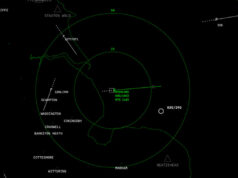
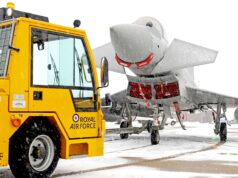
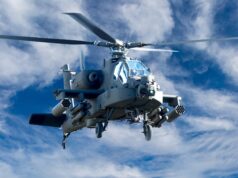
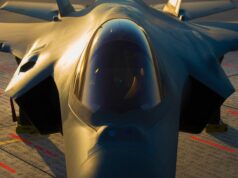
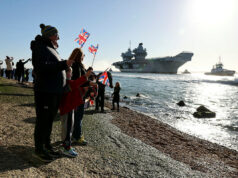

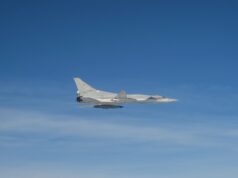
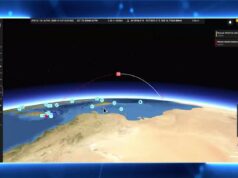
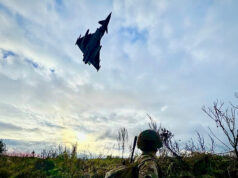

How many more typhoons are on the order books for the RAF?
I read somewhere 160 total, of which 149 have been delivered. 7 frontline squadrons equates to around 84 operational aircraft, with another 12 for OCU and the rest as spare airframe to cover combat attrition or wear and tear.
Personally I think we should have bought the full 232 planes that were originally planned. Money could have been saved for that by using Astute subs modified for Trident missiles instead of paying £31billion or more for Dreadnought.
That’s a frankly ridiculous notion. The Astutes are half the tonnage and 50m shorter than the Vanguards; modifying the Astute design to accommodate Trident would’ve resulted in either a completely new design or a heavily compromised one.
It would be nice to have those additional aircraft, but the primary concerns need to be the manpower crisis and replacing obsolete platforms
Not that I would want them to do it but Its been done before.
Polaris boats where 2 part Valiant Class hulls with a US Missile compartment fitted into the middle.
What could possibly go wrong if that was done to an Astute design!
Absolute fantasy considering modifying the Astutes….
Not at all, a fantasy to stretched a Sub.! Submarines are built in modular sections, so an extra module would be built and inserted and welded together with common Astute sections. The US Navy is building stretched Virginia’s for special ops. and SSGN. The UK’s main adversary in the northern hemisphere is Russia, which is relatively close, so a medium range missile would be sufficient to deter Russia. Majority of Russia’s ICBM’s are aimed at the USA.
We cut the order for Typhoons because the Germans (as usual) and the Italians cancelled their 2nd stage orders once the job share deal was agreed. We decided to do unto others !
Steve/Lee/David – correct me if I’m wrong but my understanding was that 232 Typhoon”s were the UK Government’s contractual obligation to the Eurofighter programme,but as an export order for 72 from Saudi Arabia was gained that is why the RAF order was reduced to 160,the numbers fit or is that pure coincidence ?
Yes I agree. I believe the 72 the RAF didn’t get were sold to Saudi Arabia which got HMG off the hook paying for them.
232 Typhoons could equate to:
10 frontline squadrons totalling 120 planes.
4 for the Falklands
12 for OCU
12 for a test and evaluation squadron
84 spare airframes.
4 isn’t enough for the Falkland really, it’s a great location for training for the crabs, when they’re not hungover. Proper dump though with very little to do besides look at sideways trees
They don’t even have anti-ship missiles do they? If Argentina actually possessed a credible navy I wouldn’t fancy their chances if they are relying on paveway and brimstone to target the ships. The submarines that I assume are permanently posted down there are what provide the real deterrent.
There are no SSN’s ‘permanently posted down there’. It was a stretch justifying a frigate ‘down there’ most of the time.
The argentine armed forces couldn’t fight their way outof appaer bag right now or for a long time in the future. When/If that changes we may need to look again.
Agreed Steve. A worthwhile investment for the RAF until the arrival of Tempest.
Cut the F35 order and replace with these, latest Super Hornet lll and new Growlers for the RN if we intend to get EMALS onboard sooner rather than later.
EMAL should be fully operational in the next two years at the very latest.
http://uk.businessinsider.com/boeing-updated-f18-comparable-f35-advanced-super-hornet-2017-1
Do you work for Boeing? That would make sense of all your anti F35 posts.
I see the sense in stopping at six squadrons of f35b provided carriers have first call and letting RAF buy more latest tranche typhoon. Astute and FAA can always do some jointery if we need day one air defence suppression with RAF typhoon following on. I think the FAA flying f35b and the RAF typhoon makes sense operationally and avoids the real risk that pooling will leave the carriers with one squadron on a routine deployment.
6 might be cutting it a bit fine, but if the government don’t plan on putting anymore than 2 squadrons on a carrier at a time (3 in a surge) then I can see that being the final number.
I don’t see any further orders for Typhoon though unless the production line is at risk of closing before Tempest is ready.
I will be surprised if there is any more than 48 F35b purchased. I expect we will see 12 operate from the carrier during a deployment, and not forgetting that the carrier won’t deploy at anywhere near the tempo that the USN operates one of their fleet carriers. Perhaps for a big exercise like RIMPAC perhaps more will be ‘scared up’. And then there are USMC squadrons to consider.
Rob, What makes sense is not buying an aircraft that has little to offer us within the next seven years. Why do you think the USA is upgrading their entire fleet to the latest standard?
Read the link, they complement the F35 not replace it.
Try thinking out of the box for once and realize the advantages of stealth are almost over. Two F18’s can already generate a weapons lock on a stealth aircraft “now”, so how much longer do you honestly think it will be before Russia or China can?
Purchasing both Block III Super Hornet and Growlers will add another dimension to our carrier air wing with far more punch and range.
Both the US and Australia are upgrading both platforms which means they too could use our carriers if required in the future.
And NO, I do not work for Boeing or any other military Company, I prefer to look at all options rather than one solution.
https://navyrecognition.com/index.php/news/defence-news/2018/march-2018-navy-naval-defense-news/6000-video-the-boeing-f-a-18-super-hornet-block-iii-is-go.html
“… realize the advantages of stealth are almost over” – bit of a sweeping statement there. Having an aircraft be less observable is always desirable because it will be detected later and be more difficult to target than an aircraft with greater observability. Its why in the link you provided one of the goals of the Super Hornet improvements is a reduced RCS. If it was useless they wouldn’t be doing it.
Oh and perhaps you can link your source for – “Two F18’s can already generate a weapons lock on a stealth aircraft now.” because it would be nice to know under what circumstances. The F35B has never been claimed to be invisible, so if you get sensors close enough to it then it will be detectable. But if your day 1 mission is to take out a S-400 SAM site then the later that detection happens the better and ideally you can launch missiles before detection.
Glass half full
“If you have a single IRST ship, with your IRST, you can get a line of bearing—it’s going to see a hot spot out there, what direction it’s in, but it doesn’t have the distance. You don’t have a weapons quality track,” Kornegay said. “Now if you combine two aircraft, the fusion algorithm, now you have lines of bearing from two different sources. Where those two sources cross, the algorithm is going to compute a weapons quality track on that aircraft. So that’s a huge advantage for the warfighter to see that long before you’re in the enemy’s radar range.”
https://nationalinterest.org/blog/the-buzz/how-the-navys-new-block-iii-super-hornet-could-crush-chinas-25964
Nigel Collins
IRST isn’t new and regardless of the new and improved IRST capabilities suggested by the Boeing spokesperson for the Super Hornet, there is nothing to say that the two Super Hornets doing the targeting, wouldn’t themselves be targeted first using IRST, radar and radio emissions detection by the stealth aircraft and taken out by BVR missiles. The Super Hornets are still going to be more observable and detectable earlier, even by IRST, than a decent stealth aircraft that is designed with low RCS and shielded heat emissions. It doesn’t necessarily mean they couldn’t get kills but they are at a disadvantage versus a less observable aircraft.
Also triangulating works best when the target is directly in front of both aircraft with good separation between the two Hornets. If the target is off to one side or the other then triangulation may not work if only one of the two Hornets has the target in range of IRST.
There is no binary stealth/no-stealth scenario only degrees of low observable capability and like most other weapons there will be an ongoing arms race to counter the various systems and designs.
From SDSR 2015, the 138 buy committed to by HMG is OVER THE LIFE OF THE PROGRAM. Small print but big meaning. Therefore, I expect no more than the 48 already committed to for some time.
Nigel, EMALS for the RN ain’t never going to happen. Chances are we’ll sell both Carriers to Brazil way before the “Planed 50 Year Service Life” Unless we get another Aircraft with the F35B’s Capability. Tempest Is looking like a good bet though, especially after “Our Gav” committed a couple of Billion of our British Pounds to It and Hearing all about the Doomed Franco German Effort. Typhoon, Tempest All we need now Is a Lanc !
I have always wanted us to get back into the heavy bomber game. Lancaster would be the perfect name.
(One of my pipe dreams, but one can dream)
An upscaled version of Tempest with four engines? Something like what you see in the 3rd image in the link below. But as you say, one can dream!
Sweeden/UK would make a very useful team.
https://saab.com/air/gripen-fighter-system/gripen/gripen-ef/
Yes, great idea, lets buy an inferior aircraft, and jeopardise thousands of skilled UK workers jobs.
What are you talking about????
Look at the third image and think Tempest. Four engine design. Think about it
Weapons carry wise will we lose anything when the Tornados are all retired are will the Typhoon have it all covered by then?
Nope we need to keep faith with the STOVL F35B. These jets and the QE class carriers will save our bacon’s at some stage. No doubt about it. Russia or our enemies could knock out the few operational fast jet airfields we have. Making Eurofighter typhoon a sitting target on the ground.
F35B. No such risk. Always able to launch and recover.
Do not get me wrong I really appreciate that typhoons as matured into one of the best multimisdion jets in the world.
I would love the RAF to order a further tranche of 30-50 aircraft to see us through to Tempest coming in-service. This order however has to be from new defence money and not take anything from the vital F35B orders needed to equip our carriers and provide close air support, first strike capability etc.
The F35B programmes needs more assurances that we will actually get the force levels needed to make a difference. Eg at least another 48-64 active aircraft within the next 3-5 years.
Evening all
I feel as though I am going to be a wet fart in a lift that’s trapped but for what it’s worth:
232 made the aircraft politically viable and would never be achieved. Aircraft shouldn’t be measured in number or frames any more but available hours, frames are still required but availability is key against the role defined.
You cannot redesign an A boat to be a D boat, platforms are designed around the weapon system they are there to deploy.
4 aircraft have served the Falklands very well since 1982, the Argentine Air Force and Navy is is no condition to launch a successful attack on the Falkland Islands, defending them is more than just what you see on the tarmac.
EMALS is not going onto CVF, commitment has been made and £100m has been spent whilst we had our “CV” moment.
Now is the time to invest in the capability to give the RN the most credible weapon system put to sea, F-18 great aircraft – in the 1980’s and for the Growler role the only one in its class.
All
Focus on the number of available hours the aircraft, regardless of type are going to provide HMG – make sure they are appropriately armed and can be in the right place at the right time. Replaying the same record, F-18/EMALS, number of Sqns and aircraft detract from what is trying to be done, extract as much capability out of what we have got (not all good) whilst being challenged by an industry that needs us to buy more.
It’s a balance, one that all too often benefits industry over capability (which isn’t their fault), which is why we find platforms being delivered years after they were originally required (Puma and Chinook for Afghanistan for example) or delivering UOR’s that has no use after the conflict had finished (Bulldog and Warthog).
500,000 hrs – not bad for a 1984 drawing almost ruined by the French, but we have learnt from our mistakes…….
Well put Lee….
More or less the point I was going to make, saved me some typing!
I know we have no plans to operate both carriers at the same time but we MUST have the capability to do so if the Shizzle hits the fan. If we only end with 3 operational squadrons and the carrier is sunk we have nothing left to put on the other.
I think 96 is the way to go – 4 squadrons each for the FAA and RAF. 3 each plus a training squadron and some spare air frames. FAA operate primary strike role, Raf are trained to fill that role as back up but are primarily land based and trained for fill the close air support role and working with the Typhoons on bombing missions. RAF then get a couple of extra squadrons of tranche 4 Typhoons to keep the production line and development going.
If a UK carrier was sunk along with all its aircraft then the remaining carrier could be fully populated with USMC F35B assuming no other UK F35B are available because that is the type of conflict we would be in if a carrier was sunk.
The USMC plan to have 340 F35B – way more than can be fitted on their amphibs. The USMC will also have F35C for use from the US carriers so their “spare” F35B’s won’t go there and would probably be a disruption to ops on a CATOBAR carrier anyway. The UK doesn’t need to cover every eventuality ourselves, that is why we are in military alliances.
So you are happy the 5th largest economy has to beg borrow and steal from other nations? Are you happy with 36 f35’s basically replacing the whole Harrier and Tornado fleets? All we see is a constant erosion of numbers in every area. I say no, we have chosen to go down the carrier strike route so let’s do it properly. If not we get rid and do something else properly as we can’t do everything. But let’s make a choice and not end up with half arsed capabilities.
I was suggesting a small reduction to save some money whilst maintaining a credible force with enough for modest attrition in a war scenario.
Size of the economy is irrelevant to this particular discussion. Tornado are being replaced by Typhoon not F35B. I didn’t argue in favour of three operational F35B squadrons, only that a second carrier isn’t useless if three is what we end up with.
You stated in your original comment “If we only end with 3 operational squadrons and the carrier is sunk we have nothing left to put on the other.” “Beg, borrow or steal” is a hyperbolic criticism for using USMC F35B in such a scenario. I simply point out that in that extreme example the reason we have allies is to fill gaps and leverage complimentary capabilities. There is nothing half arsed about using USMC aircraft form a UK carrier unless you are more focused on optics than practical deliverable capability.
Totally agree with that. Numbers are a capability in their own right
In an ideal world TS, however we have to work within a 2% GDP defence world.
As Lee points out, we have to make the assets work best as possible and make staffing and availability the focus point.
So it’s mend and make do, same tired old strategy, different day!
Fantastic achievement.
The 8th Type 26 has also been named: HMS London.
What is it with naming them completely out of Sync?
Me thinks there’s a bit of political spin involved in some of the names, but I’m not sure why they’re skipping naming hulls. This is the second time it has happened, and I’d probably attribute it to “the commitment for eight” – and it’s a lot harder to cut something that has a name.
I have never understood the whole buy airframes (or vehicles) and put them in storage to use for parts. Wouldn’t it be better to buy the parts themselves and keep the frames for the event of a serious war.
But it appears HMG has a fetish about doing this.
See the 15 stored Merlins and the 16 Typhoons that will be scrapped under the ‘reduce to produce’ jargon.
It’s not just the UK, it seems many conntries do it. Germany has been doing it with their tornadoes for example. Whilst it probably makes sense for end of life gear, it makes less sense for stuff that has many years left of service.
Lusty- it’s my understanding that the 16 Typhoon”s due to go down the RTP route are Twin-stick Trainers,if that is the case it would be a great waste, surely if they are/were anywhere near Airworthy they would make suitable Bombing tasked Aircraft,swap out the trainer for a Navigator,aka just like the Tornado,no frills or upgrades just hang Ordinance on them.
My thoughts exactly. I believe the oldest f these aircraft was first delivered in 2007, though don’t quote me on that!
Steve: You are in serious danger of making a logical, common-sense argument. The MoD does not allow that you know.
Was there talk of the RAF getting a mixed bag of F35’s. F35A as well as the F35B?
Only speculation, but the current official plans are still F35B only. Its be discussed at length on the forum and consensus seems to be that the orders will not be large enough for either model to justify splitting between the two.
God I hope not. Duplicate costs for spares, training etc etc. Also the A versiionis not STOVL therefore able to be utterly made useless should it’s airfield be hit. B Version all the way for me. Equip our carriers and provide the RAF with a close air support, first strike capability.
Absolutely Mr Bell, hoping for the full 138 order and all B models.
That would be a healthy number to support four front line squdrons, OCU, OEU, in use reserve and maintenance reserve.
Three squdrons on board for high end carrier strike, two for most operations and a single squdron embarked at all other times….
Nicholas-time is on the MOD’s side regards future F35 purchases,the Dutch across the English Channel are equipping with the “A’,the Belgian Air Force is following suit, The Italian’s will be operating a mixed fleet so any advantages or disadvantages will soon be apparent but I’d agree an all ‘B” buy looks the most likely to me.
Fellas we should scrap the subs, put trident in floating shipping containers and buy 700 Rafale am I right
It would be followed continuously by Russian subs. ready to sink it. Or tie up the ASW fleet.
Levi. LOL.
Would be good to see the RAF make an off the shelf purchase of Marte ER ASM for typhoon, not best missile out there but it’s already integrated and a typhoon with 6 would be pretty lethal to any navy. The UK relies to heavily on SSN’s for anti ship work when there are only 7. Marte ER equipped Typhoons opens up options for rapid defence of FI as well as South China Sea and FPDA allies should we ever need it.
The RAF fleet is deadly in air to air and ground Attack but it does not operate a single anti ship weapon. Even worse when F35B comes online as a naval strike weapon with no anti ship capability as well.
The UK needs to start building redundancy into its capability, an air force that can sink ships and an army that can fight without air over.
I have tried to find the answer to this but there doesn’t appear to be any clear answer. Why would the RAF use the f35b for close air support over the typhoon? The typhoon appears to be able to carry more missiles and has a bigger fuel tank, appearing to make it the better option and pushing the f35b to be a primary naval asset. Ok it can do stvol but I suspect the skills required for that are similar to landing on a carrier deck and so don’t need to be trained heavily and also won’t realistically be used outside all out war. It’s other advantage is stealth but in that config it can’t carry many missiles and so isn’t that useful from cas. What am I missing?
You need to think of the operational big picture and the environmental context i.e. peer vs peer or a limited conflict like Syria. For a peer vs peer the F35s would be predominantly used on the first few days to clear air defences and go for strategic targets such as pinch points, fuel farms and bridges. Once the air defences have been sorted the Typhoons would roll in. For something like Syria, F35s wouldn’t really be needed as Typhoon and Reaper can do the work.
I was under the impression that F35 was designed in part to replace Harrier and the A10 warthog, hence why they have a gun pod and USA are practicing attacking heavy armour.
I assumed part of having 138 F35b would be to have some for supporting ground forces in austere environments and carrying out straffing runs at ground units?
If this role is not envisioned as part of their use then we should have a split buy of a and b models. Why have a version with hugely reduced range as well as speed, manoeuvring and weapons load supporting Typhoon when we could have something far better suited for less money?
I don’t see F35 as being a CAS aircraft like A10 and Harrier. It’s more a strike/reconnaissance aircraft and a multirole fleet aircraft. More like the Tornado was originally designed for.
Is it just me or is 48 frontline F35s (based on 4 squadrons of 12 each) very low for a total of 138 aircraft?
Yes there will be an OCU squadrons and an evaluation & test one so say 12 each for that. That makes 72. That leaves 66 as spares. More spares than actual frontline aircraft. Seems daft to me.
The 138 f35bs are the total number we will buy over the whole life of the program, we will never have 138 operational unfortunately, we probably won’t even ever have 74 operational at once. 138 is for replacements of older worn out f35s and losses and pilot training ect , when you take that into account we are definitely not buying enough to be operational at the same time. We lost all of the hundreds of harriers and tornados! Well we still have 30 tornados operational but they will be gone next year.
So it looks like we will not be getting an RAF with a large fighter jet fleet like in the past. Sad! But maybe drones are the answer to help keep the RAF one of the best and capable air forces on earth. I hope we increase our Drone fleet to more than 2 squadrons eventually, but the increase from 1 to 2 squadrons is good news as long as it doesn’t erode other capabilitys any further. And we should start to build our own front line atack drones instead of buying from USA, but now it looks like we will be buying our new Drones from USA after all!
I think we should definitely be using drones for lower end roles such as CAS and ground attack against enemies such as Daesh.
I’d rather we have kept the Harriers for that role. Would have kept total airframes up while allowing the Typhoons and F35s to do the higher end roles such as air to air combat and strike missions. In the same way the Navy’s T31 frigates will take on other roles to allow the T45s and T26s to concentrate on carrier protection.
But hey ho, the Harriers are sadly gone. We could still do that with drones however. Purchase another 20 or so Reapers which are far cheaper.
With regards to drones. Not fussed if they are US designed or our own indigenous ones. Would be nice to build our own but to boost numbers for now I’d rather buy off the shelf (or build Reapers on licence) while we design and build our own next generation drones for the future.
I can not see any point of ordering any more F-35b’s until after the 2022 Block4 hardware and software upgrades release.
The 138 figure is just for show and he MOD has zero plans or Budget it ever reach it. They will keep dangling the carrot to keep the UK’s workshare. The only way it will happen is if the scrap Tempest and replace typhoon with F35.
It’ll reach it. I don’t doubt that. But sadly it’s only planning 4 squadrons worth so 48 combat aircraft. Then an OCU squadron of probably 12 and then a test & evaluation unit. The rest would be spares and come in drips and drabs to replace units as they are lost in combat/accidents or wear down due to use.
Sad really. I think they should stand up another squadron to make 5 units/60 planes. Wouldn’t have to buy any more; just have fewer spares or a smaller OCU. Given that there are so few operational F35s I can’t see that being an issue. Not like there will be that many pilots training for F35 at once.
I also think we should boost airframe numbers by purchasing some smaller, cheaper aircraft for CAS tasks. Lower end of the scale like the Navy is doing with T31. That’d leave the bigger jobs such as air to air combat and strike missions to the Typhoons and F35s.
Harrier would have been perfect had they not been cut. Reapers, perhaps, or Hawks?
In fact, I think Hawks could be perfect for the CAS role. They’re a British design, cheap to build, agile and have been used by multiple countries. We already export them all over. They also have some air to air capabilities to defend themselves.
3 o4 4 squadrons of those would expand our numbers comfortably without breaking the bank. Again, for CAS in areas where we have air superiority, or Typhoons and F35s around to take on enemy aircraft.